Top News
June 7, 2019 Ryukyu Shimpo
Freedom of expression is in a crisis in Japan.
In a new report released by David Kaye, the United Nation’s special rapporteur on the promotion and protection of the right to freedom of opinion and expression, is demanding that the Japanese government respect the right to assembly and expression, as it continues to apply pressure on things such as the protests surrounding the relocation of MCAS Futenma to Henoko in Nago.
The Japanese government should take Kaye’s criticisms seriously, and completely stop all behavior that threatens freedom of assembly and freedom of expression.
The UN’s special rapporteurs are appointed by the UN Human Rights Council (UNHRC), and is responsible for conducting surveys and observing specific counties for different areas of human rights. It is also required to act independently of any country or other organization. Kaye is an expert in international human rights law and international humanitarian law.
In a report from 2017, it notes that things such as the Special Designated Secrets Act has the potential to undermine journalism in Japan, and it recommends amending the law as well as abolishing amendment 4 of the Broadcast Act, which can be used as a justification for halting a broadcaster’s broadcast.
The report also expresses concern over the pressure the government is applying on the protests against the new base construction in Okinawa, and advised against infringing on the freedom to demonstrate in opposition of public policy, and suggested the government cooperate with the protests and related journalism.
The new report once again criticizes the Japanese government, stating that almost none of the previous report’s recommendations have been implemented.
In a globally recognized position such as Kaye’s, his statements carry a lot of weight. The status of freedom us expression in Japan, and its drastic deviation from global standards, is once again brought into the light of day. It is a situation that should cause great anxiety for the citizens of Japan, because their human rights are being disrespected.
Needless to say, freedom of expression is a basic human right that is foundational to a democratic government. If these rights are arbitrarily restricted, it allows the establishment to easily conceal any damaging information.
If information used for making a decision is not publicly accessible at the time of an election, it brings into doubt the ability to properly examine governing bodies. The result of this is a major destabilizer to the foundation of democracy.
At the construction site for the new military facilities in Henoko, the restriction of anti-base protests and news coverage is striking. At the front gate of Camp Schwab where raw materials are being trucked in, the forceful removal of protesters staging a sit-in by police continues.
Journalists are having their new coverage interrupted, they are being expelled from locations, and they are being forced to cease photography.
Chief Cabinet Secretary Yoshihide Suga rejected Kaye’s report, saying, “We cannot accept this report, which is filled with inaccuracies and unfounded claims.” To make light of the UN’s special rapporteur is inappropriate for a member of the international community. It negatively affects trust in Japan.
We cannot allow the freedom of assembly and expression to be neglected. We suggest the government engage in some serious reflection.
(English translation by T&CT and Sam Grieb)
Go to Japanese
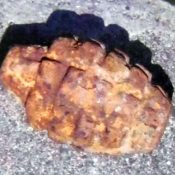
June 6, 2019 Ryukyu Shimpo
On June 5, it was discovered that several male elementary and junior high school students were found playing with an unexploded hand grenade on May 30 in Ginowan, Okinawa. The students had been throwing it around and bicycling around with it in their bicycle baskets. After a student took the grenade back home, parents reported it to the Ginowan Police Station. The grenade was then collected by the Self-Defense Forces. The students were unharmed. Schools are cautioning people not to touch bombs even if they discover them as this situation was a “near catastrophe.”
According to representatives of the Ginowan Police Stations and Ginowan Municipal Ojana Elementary School where the students attend, the students discovered the grenade in a pile of rocks near the Taimo taro field in Kakazu around 6 p.m. on May 30. The said location is along the Makiminato River that borders Ginowan and Urasoe. There is also a children’s center nearby.
According to a representative of the Ground Self-Defense Force Bomb Disposal Unit, the grenade is a U.S. hand grenade that was used during the Battle of Okinawa. It is 11.5 cm in length and weighs 640 grams. The fuse was broken, which prevented the grenade from detonating. Through the Okinawa Prefectural Police Headquarters, the Ginowan Police Station asked for assistance from the Ground Self-Defense Force’s 15th Brigade. The Ground Self-Defence Forces collected the grenade at 8:13 p.m.
On May 31, after receiving the news from the parents, Ojana Elementary School planned to caution all parents and residents of the local area by June 4. The city’s board of education also planned to caution all elementary and junior high schools within the city by June 5. Ojana Elementary School Principal Minoru Souda said, “It made me shudder. We would like to continue to advise students: “do not touch,” “do not move,” and to “notify an adult.” Other parents said they felt fear as the grenade was found in an area where their own children often play.
(English translation by T&CT and Chelsea Ashimine)
Go to Japanese
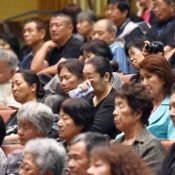
June 3, 2019 Ryukyu Shimpo
(Chatan) “It could have been me…” At an emergency memorial and protest held June 2 to remember the murder of a woman by a serviceman in the U.S. Marine Corps in Chatan, Okinawa in April, participants prayed for the victim to rest in peace and confirmed the importance of thinking of the incident not as someone else’s sorrow but as an event directly involving each and every person in Okinawa.
“As a mother [like the victim], my heart aches.” “Please don’t make Okinawans feel sorrow again.” During a relay discussion, women who, like the victim, are mothers of children, and other victims of crimes and accidents involving U.S. military service members and personnel took the stage and spoke of their thoughts and feelings.
Participants wore black hats and shirts and held up cards showing black swallowtail butterflies in honor of the victim. Before being killed, the victim had told the authorities that she was suffering domestic violence. Some of the participants kept wiping tears from their eyes as they lamented her death and thought of her child, who witnessed the scene of the crime.
Akiyoshi Murakami, former representative of the organization Victims of Incidents Caused by U.S. Military Service Members and Personnel, whose eldest son was killed by a U.S. military service member in a traffic accident, emphasized the importance of filing a civil lawsuit in such cases, saying, “It’s important that we firmly demonstrate to U.S. military members that we won’t let them get away with doing such things.”
A student, age 33, from Chatan, expressed misgivings about the relaxation of the Liberty Policy. “It will be difficult to solve these problems as long as the bases are here. U.S. military restrictions on leaving the base appear lax,” he said.
“The victim had a restraining order against the soldier, but wasn’t there any way the crime could have been prevented?” questioned a woman, 31, from Nago. “I think this harm came about because the bases are here. I want to make sure I think about the issue as something directly relating to me,” said a University of the Ryukyus student, age 24, who attended with her mother, age 56.
(English translation by T&CT and Sandi Aritza)
Go to Japanese
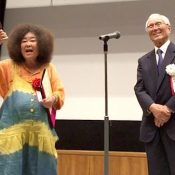
June 3, 2019 Ryukyu Shimpo
The Photographic Society of Japan held an awards ceremony on Jun 3, at the Sasakawa Hall in Tokyo, where Mao Ishikawa was awarded the 2019 Lifetime Achievement Award. Ishikawa was presented a certificate and a trophy. She pledged to “Continue to create ‘made in Okinawa’ photography as long as I’m physically able to.”
The photographer was introduced as having won the award for her “Ongoing work to produce photography and organizing exhibits, and for her creative work in portraying Okinawa’s history of adversity in the ‘Dai-Ryukyu Syashin Emaki’ exhibit.”
Ishikawa delivered her acceptance speech in her “classic Mao” rhetoric: “I am Okinawan, not Japanese. I despise Japan—Japan bullies Okinawa.” However, she praised the association that selected her and said, “there are many Okinawan photographers producing great work. I wasn’t getting recognized and was frustrated. I thought many of the works [selected] tended to circumspect the central government, but [the association] made two selections for the reason that its subject was military-related, which amazed me.” She went on to assert that, “There’s an air of gloom in Japan, and the art world has become cowardly. There is a lot of work out there that is completely uninteresting.” She vowed to “continue taking photographs ‘made in Okinawa.’”
Seven others were awarded alongside Ishikawa at the award ceremony: the Newcomer’s Award went to Inbe Kawori and Ryo Minemizu, who photographs in Okinawan waters; Manfred Heiting and Kaneko Ryuichi won the International Award; Keisou Tomioka and Naohisa Hara was awarded the Distinguished Contributions Award; and Chihiro Minato won the Scholastic Achievement Award.
(English translation by T&CT and Monica Shingaki)
Go to Japanese
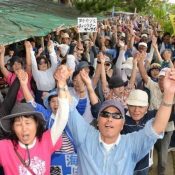
June 2, 2019 Ryukyu Shimpo
On June 1 there was a large prefectural protest against construction of the Futenma Replacement Facility (FRF) in Henoko, Nago City, which met in front of the gate to Camp Schwab. About 700 people attended, affirming their solidarity in calling for base construction to stop.
Representative Hiroshi Ashitomi of the Helicopter Base Objection Association said, “Many of us Okinawans must come together at the site of the struggle.” He brought up that people across Japan are calling for Henoko construction to stop: “All-Okinawa’s fight has also spread to the mainland. Let’s concentrate the people’s power as one and tackle this problem.”
Speakers at the protest said things like, “We oppose military bases, which lead to war.” A canoe team is keeping up protest activities on the ocean, and calling for more such attendance on the water. One team member said, “Although this is becoming a long fight, let’s do our best.”
A group of six family members spanning three generations attended from Nakagusuku Village, including Yuta Arakaki, 27, who works as the manager of a company. He said: “The Okinawan people are proud of the beautiful ocean with its coral, and these should be left alone. The seawalls are still partial, so [these things] can still be recovered. Even though I have seen only a little [of what is happening] at the site, I want to convey it to others in my generation.”
(English translation by T&CT and Erin Jones)
Go to Japanese
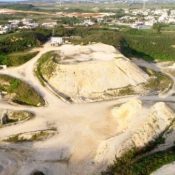
June 4, 2019 Ryukyu Shimpo
By Manato Akira
It was learned on June 2 that in a Japanese Self Defense Force (JSDF) training materials, there is a section that says that when a surface-to-ship guided missile is surrounded by flames, the time it takes for it to explode is about two minutes, and it is advised to take measures such as moving outside of a one kilometer perimeter or otherwise take shelter. Military commentator Makoto Konishi expressed concerns about such missiles which are stored in Miyakojima and Ishigaki, saying, “While certainly during an emergency, even in times of peace the possibility of a fire cannot be avoided. How will residents be able to evacuate outside the kilometer perimeter in only two minutes?” Since these ammunition depots contain missile with devastating destructive capability, they are generally located inside a mountain, and Konishi indicates, “The fact that these ammunition depots are placed close to where people live is in itself strange.”
The training materials were obtained by Konishi via a right-to-know request.
In the training material, it says that when there is fire surrounding the missiles, “Once the warhead is engulfed in flames, there are two minutes until it ignites, possibly causing an explosive reaction… evacuate to a distance of one kilometer, or take cover in a shelter.”
Konishi acquired a textbook from the JSDF weapons school entitled Artillery Shells, Rockets, and Guided Missiles, as well as related materials, a total of 647 pages. The material explains in detail the structure, functions, and specific handling instructions for each type of ordinance.
At the end of March this year, a plan was concocted to deploy a missile corps to the Miyakojima Garrison starting in 2020, in addition to the 380 soldiers already stationed there. Along with this, if the Ministry of Defense’s plan to construct an ammunition depot in the Hora district of Miyakojima is completed, they plan to store surface-to-ship and surface-to-air missiles as well.
Near the proposed construction site for the ammunition depot, there are houses and roads, meaning the missiles would be alongside residents as they go about their daily lives.
On Ishigaki Island, the plan is to deploy a missile corps of around 500-600 soldiers. Here, there is a plan to store guided missiles in the ammunition depot at the garrison as well, and construction on the garrison began in March. Near the garrison is the village of Kainan.
(English translation by T&CT and Sam Grieb)
Go to Japanese

May 30, 2019 Ryukyu Shimpo
By Hideaki Yoneda
Takashi Matsuda, 46, of the diving shop Relax Island in Aharen, Tokashiki Village confirmed that the coral of Aharen Beach spawned on the nights of May 22 and 23.
Only once a year, in May or June during the flood tide around the full moon, the coral release their eggs and sperm into the ocean for fertilization.
According to Matsuda, who observed the coral spawning at Aharen Beach, Acropora coral species including staghorn coral (Acropora muricata) released a large quantity of gametes into the water at around 10:00 p.m. on the 22 and 23.
Matsuda said, “Although I watch coral spawning every year, whenever I see it I am moved. The way the eggs steadily rise to the water’s surface is very mystical.”
(English translation by T&CT and Erin Jones)
Go to Japanese

May 28, 2019 Ryukyu Shimpo
Recently Okinawa Governor Denny Tamaki sent his first correspondence to the U.S. government, requesting the prompt suspension of operations on Marine Corps Air Station (MCAS) Futenma. The Okinawa Prefectural Government (OPG) is once more appealing for an immediate halt to operations, due in part to the five-year period within which the Japanese government had promised Okinawa that operations on MCAS Futenma would be terminated hitting its deadline in February this year, and results of the prefectural referendum showing that more than 70 percent of Okinawans oppose Futenma Replacement Facility (FRF) construction in Henoko. Governor Tamaki’s missive states that the OPG believes that the relocation to Henoko will not bring about the prompt elimination of the dangers posed by MCAS Futenma.
According to the OPG, this is the first time that Okinawa’s governor has corresponded directly with the U.S. government requesting the suspension of operations on MCAS Futenma. Governor Tamaki sent the letter on May 24 and officially announced it on May 27. He commented, “I want the United States government to heed the will of the Okinawan people, and work toward suspending operations on the airfield and eliminating the danger as soon as possible.”
The missive was sent to four people: U.S. Ambassador to Japan William Hagerty and Commander of the United States Forces, Japan (USFJ) Kevin Schneider, and residing in Okinawa, Consul General of the U.S. to Okinawa Robert Koepcke and Okinawa Area Coordinator (OAC) Eric Smith. In the letter, Governor Tamaki asks for the letter to be forwarded to President Trump. An Okinawan official said that the document aims to make known that the new base is bound to lead to problems for the United States, too.
This missive brings up the dangers of MCAS Futenma, including the current overlarge share of the base burden on Okinawa, the helicopter crash onto an Okinawa International University building in the vicinity of MCAS Futenma in 2004, and the helicopter window part that fell on Futenma Daini Elementary School in 2017. It goes on to explain that the population density of Ginowan City, which bears MCAS Futenma, has approximately the population density of Chicago.
Furthermore, the missive presents the fact that over 70 percent of Okinawans who voted in the prefectural referendum voted in opposition to land reclamation as part of FRF construction in Henoko, Nago City. It points out that since soft ground has been found in the construction area, completion of the FRF remains uncertain.
The letter also reminds readers that ground improvement work is planned only for aircraft runways. It continues, “This means that once an earthquake occurs, all reclaimed areas other than runways would become liquefied and unusable as a military base. If a seawall collapses or suffers damage, the recovery of the landfill area is beyond feasible. As stated, the existence of soft ground potentially impairs the Marine Corps readiness against foreign aggression.”
(English translation by T&CT and Erin Jones)
Go to Japanese

May 30, 2019 Ryukyu Shimpo
The “Kadena Air Base Tri-City Intercommunication Committee,” which is comprised of representative from Okinawa City, Kadena, and Chatan and chaired by Kadena mayor Hiroshi Toyama, visited Okinawa Defense Bureau (ODB) chief Toshinori Tanaka May 29 to protest repeated incidents involving U.S. airmen including drunk driving and other incidents. Only the opening of the meeting was made public. Afterwards, Mayor Toyama commented to the press that the previous day he had grown fed up with the continued scandals involving U.S. airmen stationed at Kadena Air Base which had “gone way too far,” and so he went to the head of the ODB to, “demand the U.S. military establish some discipline and put a thorough effort into ensuring another incident does not occur.”
Originally, the meeting was formed to protest parachute training that had taken place at Kadena on May 21, but as the scandals continued to pile up, the committee quickly added points of protest such as the breaking of road laws by U.S. airmen among others.
OBB chief Tanaka recognized, “Crimes including drunk driving committed by U.S. airmen are repeated occurrences,” and said that he demanded the U.S. military take steps to prevent reoccurrence and to thoroughly educate soldiers. When asked about the May 26 traffic accident involving a vehicle from the air base that resulted in a death, and specifically about financial compensation for the victim’s family, Tanaka stated his stance as, “As a general rule, any incident outside of official business should be handled between the parties involved.” However, he commented that there are many systems in place for this and that he “wants to respond [as the Japanese government] in a suitable fashion.”
(English translation by T&CT and Sam Grieb)
Go to Japanese

May 30, 2019 Ryukyu Shimpo
Following the discovery of hazardous substance in tap water, filtration plants, and water sources, a group of women alarmed by the situation established the “Association of Mothers Requesting Safe Water.” The source of the pollution is suspected to be the U.S. military bases stationed in Okinawa.
On May 29, representative Ai Yamamoto held a press conference at the Okinawa Prefectural Office Journalist Club. Seeing how the water contains substances potentially harmful to human health as a problem, she said, “We cannot help but say (that the current situation) is unacceptable.” On the same day, the association submitted a petition to the Okinawa Prefectural Government (OPG) requesting to eliminate harmful substances from the water.
The association questions how the water is deemed “safe because (the contamination levels) are lower than the U.S. standards” even though organofluorine compounds, such as PFOS, PFOA, and PFHxS are found in the tap water. Organofluorine compounds are carcinogenic and can potentially impair development in unborn children and infants. On May 25, the association was established in hopes of demanding safe water from the standpoint of residents that protect and raise children. As of May 29, more than 100 individuals and groups support the association.
The petition requests actions in three stages: 1) immediate countermeasures, 2) medium-term countermeasures, and 3) long-term countermeasures. The immediate countermeasures requests that the OPG notify residents in suspected areas of tap water pollution, and to advise people to avoid using the water for drinking and for making formula milk. The long-term countermeasures demands OPG increased access to U.S. military bases suspected of being the source of the contamination.
(English translation by T&CT and Chelsea Ashimine)
Go to Japanese

May 26, 2019 The Ryukyu Shimpo
On May 25, protesters rallied across the nation to stop the construction of the new base in Henoko, Nago City. While many cities in Japan recorded the hottest day of the year yet, protestors hit the streets, held gatherings and talks at 38 locations across 32 prefectures. According to organizers, a crowd of five thousand gathered near the Diet building in Tokyo, voicing their objection to the central government: “Defer to the will of the Okinawan people.”
This is the first time a nation-wide movement was organized since a prefectural referendum was held in February to vote on the landfill work involved in the construction of a new base in Henoko. Given the central government’s indifference toward public opinion and its forceful hand in continuing the construction work, a number of speakers took the podium near the Diet building, questioning the nation’s democratic processes. Some proposed requesting local assemblies to adopt position statements in an attempt to disseminate Okinawan public opinion.
One of the organizers, Shinsaku Nohira, greeted the crowd and said, “This time, given the results of the prefectural referendum, the ball is fully in the court of mainland Japan. We are responsible for finding a solution.” Nohira alluded to Defense Minister Takeshi Iwaya’s earlier response to the results of the prefectural referendum, in which the minister stated, “Okinawa has its own form of democracy, and the country has its own form of democracy.” Nohira said, “If the will of the Okinawan people is not honored, it would mean that there is no democracy in Japan.”
Gov. Denny Tamaki also gave a statement, in which he said the Abe administration’s handling of the issue “is threatening constitutional principles.” Hiroshi Ashitomi, co-leader of a group opposing U.S. military heliports in Okinawa said, “Giving up is not an option if we want to win. I hope people will adopt this motto and continue fighting.”
Satoko Uchiyama, a member of the Tokyo Musashino City Assembly, who in March adopted a position statement soliciting the central government to honor the results of the referendum said, “The main islands of Japan should be initiating the opposition movement. Tokyo is expected to indicate its intentions and take action.”
(English translation by T&CT and Monica Shingaki)
Go to Japanese










 Webcam(Kokusai Street)
Webcam(Kokusai Street)


